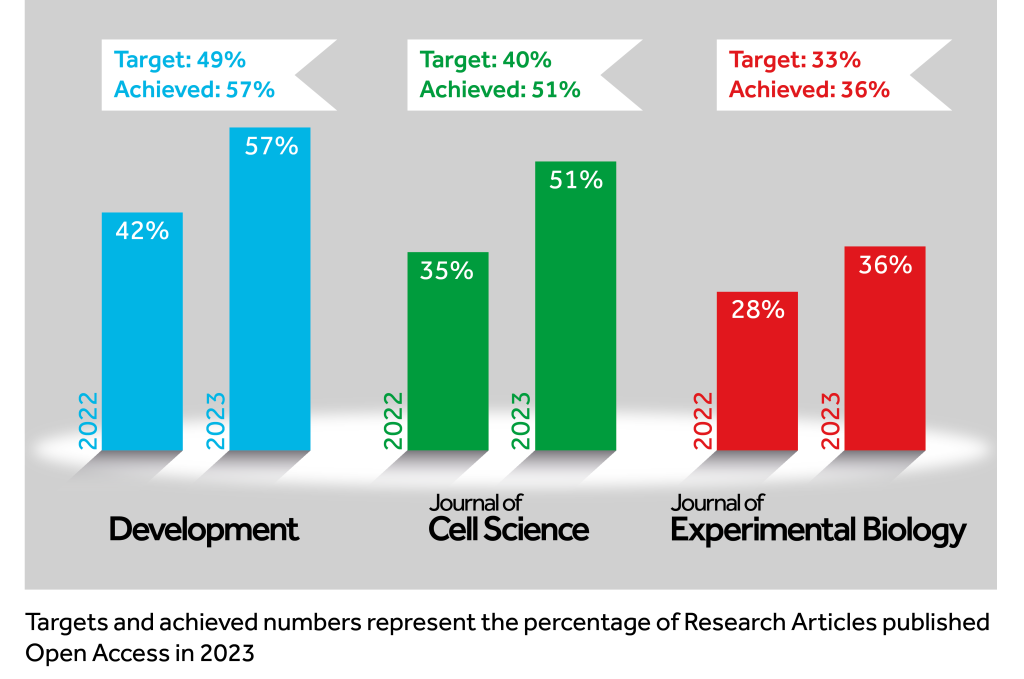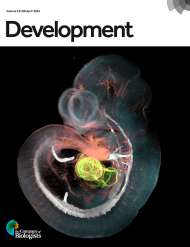Transformative Journals
The Company of Biologists’ three hybrid journals – Development, Journal of Cell Science and Journal of Experimental Biology – have chosen the ‘transformative’ route towards Open Access.
As the first journals to be afforded Transformative Journal status by Plan S, we are excited about this next step in our Open Access journey.
For 2023, all three journals have exceeded their Transformative Journal targets for Open Access growth.
We have offered Open Access publishing options since 2004 and two of our five journals are already fully Open Access. We believe that Open Access is the direction of travel and it is clear that, as well as reader benefits, Open Access provides our authors with a wider readership and higher usage for their articles.
The Transformative Journal strategy signals more clearly our commitment to move towards Open Access, while allowing us to provide publishing options that support all our authors as we approach this change in the publishing landscape.
This helps us balance these two priorities:
- making research accessible to everyone, as quickly as possible
- supporting our whole author community – whatever their funder or financial status
What are Transformative Journals?
Transformative Journals proactively champion Open Access publishing and have Open Access growth targets. By providing a transition period, the Transformative Journal model acknowledges that not all of our authors are ready for Open Access (which requires support from their funders and institutions) and ensures that every author in our community can continue to publish with us.
How are Transformative Journals different from hybrid journals?
As hybrid journals, Development, Journal of Cell Science and Journal of Experimental Biology already offered Open Access publishing options.
As Transformative Journals they will continue and extend their Open Access support by:
- gradually increasing the share of Open Access research content year on year
- promoting the benefits of Open Access publishing
- providing transparent metrics for published articles
- providing comparative metrics for Open Access articles compared with subscription content
- providing greater transparency on the services covered by the article processing charge (APC)
- offering ‘transformative’ Read & Publish agreements to libraries/consortia
- continuing to offset subscription revenue to avoid ‘double dipping’
What does this mean for authors?
Authors will still have the same three routes to publication as we transition towards Open Access:
Free publication (not Open Access)
With this option, the author pays nothing at all. The article is available to our subscribers for six months and is then freely available to everyone after this time.
This option might appeal to authors whose funders and institutions do not mandate Open Access and authors who do not want to choose Open Access or pay an Open Access fee. This option could be important given the financial challenges within the university sector.
Open Access (author pays)
The author will pay an article processing charge (APC) to publish their article Open Access. Articles will be published under a CCBY licence and will be available to everyone immediately upon publication.
This option will appeal to authors whose funders or institutions mandate Open Access or to authors who prefer to publish Open Access.
Read & Publish agreements
The third option is for authors whose institutions have taken up one of our Read & Publish agreements. These cost-neutral agreements, agreed with librarians, provide unlimited access to all of our content and allow corresponding authors from that institution unlimited APC-free Open Access publication for research articles. These agreements therefore support institutions and authors working to meet funding requirements and to make Open Access the default publishing choice.
Is this Plan S compliant?
Yes, our commitment to the Transformative Journal approach makes us Plan S compliant, which supports those of our authors with cOAlition S funding. By continuing to offer authors choices, we ensure that we support our whole author community whatever their funder and financial status. We anticipate the proportion of authors selecting Open Access will grow year on year, with the support of their funders and institutions.
What is the timeline for transformation?
Development, Journal of Cell Science and Journal of Experimental Biology aim to:
- grow the proportion of Open Access research content by 5% year on year (or 15% in relative terms) over the transition period 2021—2024. This will require the support of funders and institutions as we promote Open Access publishing to their authors.
- transition to full Open Access when the journals reach 75% Open Access research content. Journals could transition earlier with the support of the journal communities. Financial support from cOAlition S funders for hybrid journals ends on 31 December 2024.
- report annually on our transformational journey. Our Open Access growth targets are challenging and require real changes in the marketplace such as funder mandates (including financial support for Open Access) and more libraries/consortia taking up our Read & Publish deals. We will monitor our progress on this Open Access journey closely and will openly report on it, ensuring we work together with stakeholders to maximise the chances of success.
We call for authors, funders and librarians to join us on our Open Access journey.
Our progress
For 2023, all three Transformative Journals have exceeded their targets for OA growth (research content).

- Transformative Journals – year three report
- Transformative Journals – year two report
- Transformative Journals – year one report
- Transformative Journals – year zero report
Our target for 2024 is to gain a further at least 5% points increase in the proportion of Open Access research content and at least 15% growth of the number of OA articles, over the period 2021-2024 (whichever number is higher is the actual target). For our journals, this means aiming for the following numbers:
| Total number of research articles published in 2023 | Number of research articles published OA in 2023 | OA as % of research articles published in 2023 | OA as % of research articles to be published in 2024 to meet absolute growth target of 5% | OA as % of research articles to be published in 2024 to meet relative growth target of 15% * | |
|---|---|---|---|---|---|
| Development | 287 | 163 | 57% | 62% | 66% |
| Journal of Cell Science | 212 | 108 | 51% | 56% | 59% |
| Journal of Experimental Biology | 267 | 96 | 36% | 41% | 41% |
* as this is the higher number, this is our actual target for 2024.
Feedback from our authors
We have received overwhelmingly positive feedback from our authors, as they are able to choose the publishing option that suits their needs best. Read & Publish agreements specifically have made a big difference for authors at participating institutions, allowing them to publish their research Open Access, when they might not otherwise have had the opportunity to do so. Below is a selection of recent feedback. You can find out more on our page What authors say.
Assistant Professor Khursheed Iqbal, Oklahoma State University, USA
“The free Open Access option proved the optimal choice, not just by simplifying the process but also by granting us publication in a prestigious journal like Development, all without the usual financial burden. This is truly a game-changer for science publishing. This sets a powerful precedent for a more equitable and accessible scientific publishing landscape. I hope more journals adopt this model, paving the way for a future where Open Access becomes the norm.”
Professor Doug Winton, CRUK Cambridge Institute, University of Cambridge, UK
“We were delighted that The Company of Biologists has a Read & Publish agreement with the University of Cambridge. Such agreements are fundamental to the culture of Open Access without financial burden. It’s great to see agreements in place which include less-established institutions and researchers and ensure better access to publishing across the globe.”
Jessica Tingle, The University of Akron, USA
“For the second time, I find myself very thankful for the agreement between The Company of Biologists and The University of Akron. I very much favor publishing my articles Open Access, but as a post-doc with limited funds, I can’t pay for high APCs. The Read & Publish agreement has twice given me the opportunity of APC-free Open Access!”








You must be logged in to post a comment.